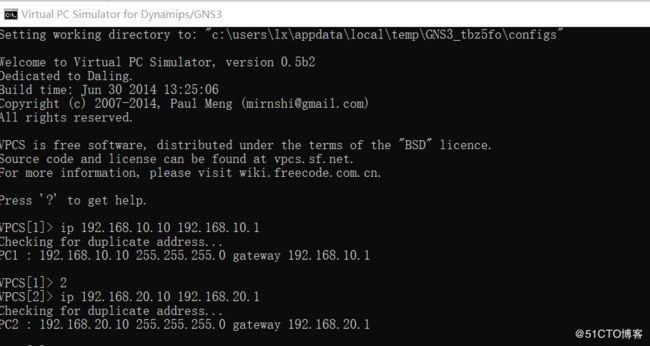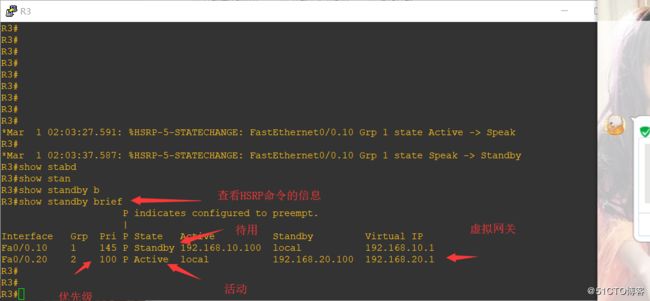热备份路由器协议(HSRP)的设计目标是支持特定情况下 IP 流量失败转移不会引起混乱、并允许主机使用单路由器,以及即使在实际第一跳路由器使用失败的情形下仍能维护路由器间的连通性。实现HSRP的条件是系统中有多台路由器,它们组成一个"热备份组",这个组形成一个虚拟路由器。换句话说,当源主机不能动态知道第一跳路由器的 IP 地址时,HSRP 协议能够保护第一跳路由器不出故障。
下面对拓扑图进行配HSRP的配置命令:
SW的配置命令:
sw(config)#no ip routing 关闭路由功能
sw(config)#vlan 10,20 创建vlan
sw(config)#int f1/0
switchport access vlan 10
sw(config)#int f1/1
sw(config-if)#switchport access vlan 20 划分vlan
sw(config)#int f1/2
sw(config-if)#switchport mode trunk
sw(config)#int f1/3
sw(config-if)#switchport mode trunk 接口改为trunk接口
SW-3L的配置:
sw-3L(config)#vlan 10,20 创建vlan
sw-3L(config)#int f1/0
sw-3L(config-if)#switchport mode trunk 改为trunk接口
sw-3L(config)#int f1/1
sw-3L(config-if)#switchport access vlan 1 划分vlan1 vlan1是三层交换机默认的
sw-3L(config)#int vlan 1
sw-3L(config-if)#ip add 192.168.30.1 255.255.255.0
sw-3L(config-if)#no shut
sw-3L(config)#int vlan 10
sw-3L(config-if)#ip add 192.168.10.100 255.255.255.0
sw-3L(config-if)#no shut
sw-3L(config)#int vlan 20
sw-3L(config-if)#ip add 192.168.20.100 255.255.255.0
sw-3L(config-if)#no shut vlan配置网关和掩码
sw-3L(config)#int vlan 10
sw-3L(config-if)#standby 1 ip 192.168.10.1 设置虚拟HSRP的ip网关 1是分组
sw-3L(config-if)#standby 1 priority 150 配置HSRP的优先级 优先级范围是0~255 默认是100
sw-3L(config-if)#standby 1 preempt 配置HSRP的占先权
sw-3L(config-if)#standby 1 track f1/1 跟踪端口
sw-3L(config)#int vlan 20
sw-3L(config-if)#standby 2 ip 192.168.20.1
sw-3L(config-if)#standby 2 priority 95
sw-3L(config-if)#standby 2 preempt 这是2组备份
sw-3L(config)#router ospf 110
sw-3L(config-router)#network 192.168.10.0 0.0.0.255 area 0
sw-3L(config-router)#network 192.168.20.0 0.0.0.255 area 0
sw-3L(config-router)#network 192.168.30.0 0.0.0.255 area 0 设置动态路由OSPF
R3的配置命令:
R3(config)#int f0/1
R3(config-if)#ip add 192.168.40.1 255.255.255.0
R3(config-if)#no shut 设置端口ip
R3(config)#int f0/0
R3(config-if)#no shut 开启端口
R3(config)#int f0/0.10
R3(config-subif)#encapsulation dot1Q 10
R3(config-subif)#ip add 192.168.10.200 255.255.255.0
R3(config-subif)#no shut
R3(config)#int f0/0.20
R3(config-subif)#encapsulation dot1Q 20
R3(config-subif)#ip add 192.168.20.200 255.255.255.0
R3(config-subif)#no shut 设置单臂路由
R3(config)#int f0/0.10
R3(config-subif)#standby 1 ip 192.168.10.1
R3(config-subif)#standby 1 priority 145
R3(config-subif)#standby 1 preempt 设置1组备份
R3(config)#int f0/0.20
R3(config-subif)#standby 2 ip 192.168.20.1
R3(config-subif)#standby 2 preempt
R3(config-subif)#standby 2 track f0/1 创建HSRP 步骤以上有解释,不做多解释
R3(config)#router ospf 110
R3(config-router)#network 192.168.10.0 0.0.0.255 area 0
R3(config-router)#network 192.168.40.0 0.0.0.255 area 0
R3(config-router)#network 192.168.40.0 0.0.0.255 area 0 设置动态路由OSPF
R1的配置命令:
R1(config)#int f0/0
R1(config-if)#ip add 192.168.30.2 255.255.255.0
R1(config-if)#no shut
R1(config)#int f0/1
R1(config-if)#ip add 192.168.40.2 255.255.255.0
R1(config-if)#no shut
R1(config)#int f1/0
R1(config-if)#ip add 12.0.0.1 255.255.255.0
R1(config-if)#no shut 配置端口ip
R1(config)#router ospf 110
R1(config-router)#network 192.168.30.0 0.0.0.255 area 0
R1(config-router)#network 192.168.40.0 0.0.0.255 area 0
R1(config-router)#network 12.0.0.0 0.0.0.255 area 0 设置动态路由
R5的配置命令:
R5(config)#int f0/0
R5(config-if)#ip add 12.0.0.2 255.255.255.0
R5(config-if)#no shut 配置端口
R5(config)#router ospf 110
R5(config-router)#network 12.0.0.0 0.0.0.255 area 0 设置动态路由
VPCS设置IP,然后尝试pc1和pc2访问R5,看看通过HSRP往哪里访问:
关闭sw-3L的端口,看看pc1是否通过R3访问R5:






